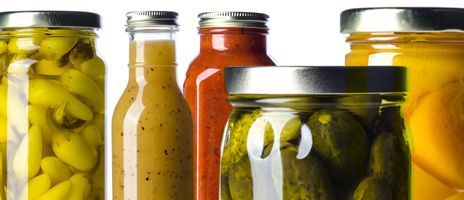3 Types of Plastisol Canning Caps and Why You Need To Know the Difference


Lining the inside ring of the metal cap used on your glass-clad food preserves is a magical substance called plastisol. This rubberish, vinyl-ish, plastic-y substance does ALL of the work when it comes to keeping the good stuff in and the bad stuff out.
When preserving foods for future consumption, there’s an understandable degree of trepidation when it comes to getting the right packaging. The last thing you want to do is open a jar of salsa and find that it’s been rotting for the last year instead of “keeping.”

The three types of plastisol
There are three types of plastisol: (1) standard, (2) pasteurization-grade and (3) retort. Each type has been designed to meet specific food-preserving process specifications. If you use the wrong kind of cap, the plastisol liner could disintegrate or not respond properly … resulting in a great big mess of rotten food.
1. Standard Plastisol
Standard plastisol caps are recommended for Hot Fill and Cool heat process treatments (see Canning Wheel graphic below). This process typically involves filling properly prepared glass containers with properly heated food or beverages and sealing with properly prepared caps. As the food cools, a vacuum seal is created with your standard-grade plastisol caps. You can find these caps on our website under metal caps with a liner type of plastis-stndrd.
2. Pasteurization-Grade Plastisol
Pasteurization-grade plastisol caps are recommended for both Hot Fill and Pasteurize and Cold Fill and Pasteurize heat process treatments (see Canning Wheel graphic below). These processes typically involve filling properly prepared glass containers with either hot or cold food, sealing with properly prepared caps, and then pasteurizing (or hot-water-bathing) the filled and sealed container. You can find these caps on our online catalog under metal caps with a liner type of plastis-pasteur.
Shop pasteurization-grade plastisol caps
3. Retort-Grade Plastisol
Retort-grade plastisol caps are recommended for “Sterilization (Retort) with Overriding Pressure” heat process treatments (see Canning Wheel graphic below). These processes typically involve high heat and pressure-cooking of filled and capped containers. We don’t currently stock any plastis-retort caps, but we can definitely get them for you.
Contact us about retort-grade plastisol caps
Technical Specifications
Here’s a nifty chart that shows you the sweet spots between processes, temperatures and plastisol types.
| Heat (Process) Treatment | Minimum sealing temperature* | Maximum Process Temperature | Recommended Plastisol Type |
| Hot fill and cool | 185 °F / 85 °C | 185 °F / 85 °C | Standard (plastis-stndrd) |
| Cold fill and pasteurize | 68 °F / 20 °C | 185 °F / 85 °C | Pasteurization (plastis-pasteur) |
| Hot fill and pasteurize | 149 °F / 65 °C | 195 °F / 90 °C | Pasteurization (plastis-pasteur) |
| Sterilization (retort) with overriding pressure | 149 °F / 65 °C | 250 °F / 121 °C | Retort (plastis-retort) |
| * Sealing temperature is used to represent the temperature of the product in the jar after capping, and not the temperature of the product in the filler bowl. | |||
Canning Wheel, Second Edition
In case you’re more visually-oriented, here’s a second edition of our Canning Wheel that summarizes this entire blog post in one delightful image.

Please test first!
We cannot guarantee that any container will function properly with your particular product.
We will provide you with samples of most of our products free of charge (customers will pay for freight charges). Please test your products with each container before filling large runs! Browse our glass jars on our website.
Container & Packaging Supply, Inc. assumes no responsibility for suitability of any container or closure for customer’s particular use. It is the customer’s responsibility to do product compatibility testing with containers and closures selected by the customer. We are not responsible for consequential damages arising from customer’s selection and use of containers and closures supplied by us.